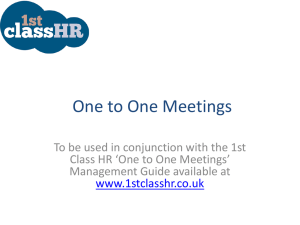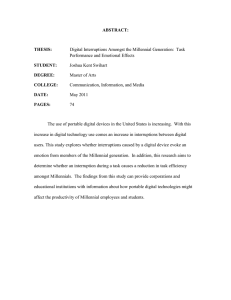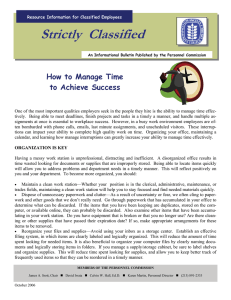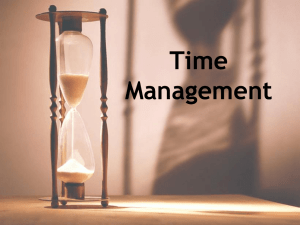Interruption patterns in British parliamentary debates and drama dialogue Cornelia Ilie 1
advertisement
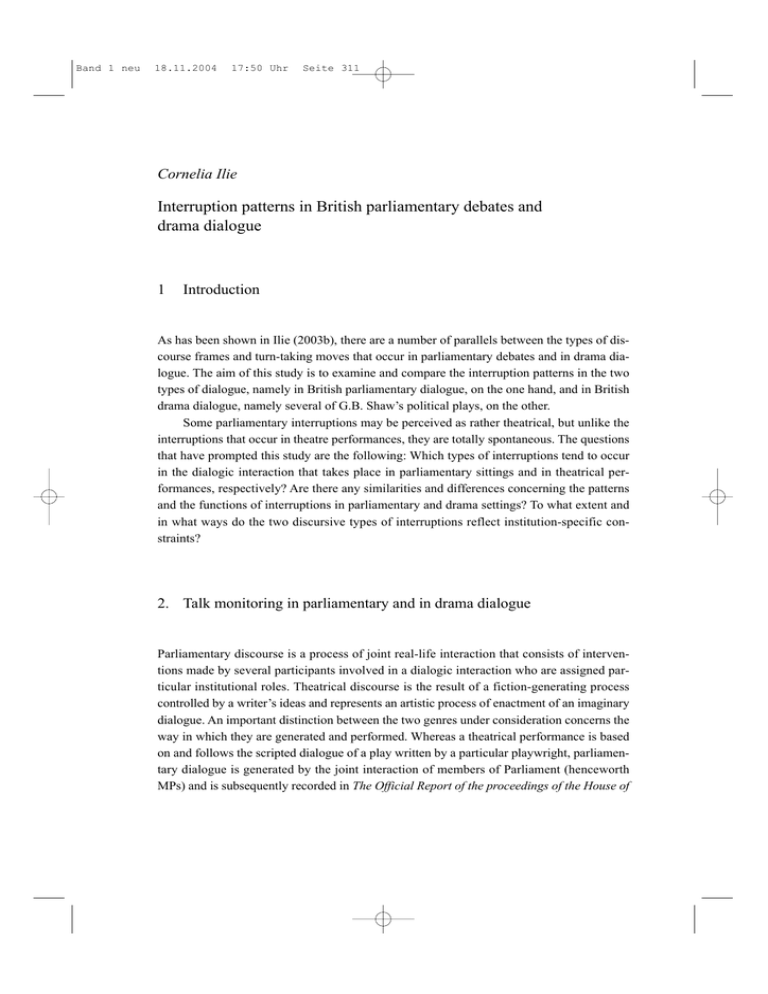
Band 1 neu 18.11.2004 17:50 Uhr Seite 311 Cornelia Ilie Interruption patterns in British parliamentary debates and drama dialogue 1 Introduction As has been shown in Ilie (2003b), there are a number of parallels between the types of discourse frames and turn-taking moves that occur in parliamentary debates and in drama dialogue. The aim of this study is to examine and compare the interruption patterns in the two types of dialogue, namely in British parliamentary dialogue, on the one hand, and in British drama dialogue, namely several of G.B. Shaw’s political plays, on the other. Some parliamentary interruptions may be perceived as rather theatrical, but unlike the interruptions that occur in theatre performances, they are totally spontaneous. The questions that have prompted this study are the following: Which types of interruptions tend to occur in the dialogic interaction that takes place in parliamentary sittings and in theatrical performances, respectively? Are there any similarities and differences concerning the patterns and the functions of interruptions in parliamentary and drama settings? To what extent and in what ways do the two discursive types of interruptions reflect institution-specific constraints? 2. Talk monitoring in parliamentary and in drama dialogue Parliamentary discourse is a process of joint real-life interaction that consists of interventions made by several participants involved in a dialogic interaction who are assigned particular institutional roles. Theatrical discourse is the result of a fiction-generating process controlled by a writer’s ideas and represents an artistic process of enactment of an imaginary dialogue. An important distinction between the two genres under consideration concerns the way in which they are generated and performed. Whereas a theatrical performance is based on and follows the scripted dialogue of a play written by a particular playwright, parliamentary dialogue is generated by the joint interaction of members of Parliament (henceworth MPs) and is subsequently recorded in The Official Report of the proceedings of the House of Band 1 neu 18.11.2004 17:50 Uhr Seite 312 312 Cornelia Ilie Commons (easily accessible from the British Parliament home page on the internet: <http:// www.parliament.uk>). The MPs’ performance in Parliament can be regarded as a spontaneous dialogic interaction, while the actors’ performance on stage is a rehearsed dialogic interaction. The MPs’ interventions are monitored by the Speaker of the House, whose major task is to ensure a smooth unfolding of the proceedings. The Speaker’s talk monitoring is exerted prospectively, by assigning an orderly turn-taking and by giving the floor to MPs according to a pre-established list of speakers, but also retrospectively, by sanctioning disorderly behaviour in the House, such as out-of-order interruptions. In staged drama, an initial monitoring process is carried out by the playwright him/herself, who is responsible for designing the character- and plot-based dialogue. A secondary monitoring is carried out by the stage director, who is responsible for proposing a particular interpretation of the text and for bringing about, together with the actors, a particular performance of the dramatic dialogue. In other words, the performance of a staged drama is normally marked by a double dialogue monitoring. This is a prospective type of monitoring, whereas speech monitoring in Parliament is an ongoing monitoring, both prospective and retrospective. A significant similarity between parliamentary and drama interaction consists in the fact that not only actors’ performances, but also MPs’ speeches and interventions are being watched by an onlooking audience. Speaking MPs in the British Parliament are fully aware of being scrutinised by a multi-layered audience, i.e. the insider audience of fellow MPs, the outsider audience of visitors in the Strangers’ Gallery, and the outsider audience of TV-viewers. The actors on stage know very well that their character impersonation and the show they are putting on are for the sake of the theatre audience. An important difference, however, consists in the fact that parliamentary dialogue, unlike drama dialogue, can fulfil its institutional purpose (basically debating political issues and making political decisions) even in the absence of an outsider audience (visitors or the public at large). The major prerequisite for MPs to fulfil their institutional tasks is the presence of their fellow MPs. 3. Previous approaches to interruptions vs. overlaps One of the most widespread observations made by conversational analysts (Sacks/Schegloff/Jefferson 1978, Ervin-Tripp 1979, Goodwin 1981) with regard to turn-taking moves assumes that interlocutors take turns at speaking. However, further research has shown that a considerable number of overlaps occur when two speakers engaged in a dialogue happen to speak simultaneously. Moreover, it also became apparent that the number of participants Band 1 neu 18.11.2004 17:50 Uhr Seite 313 Interruption patterns 313 may vary from two to twenty or more, that turns at speaking can vary from minimal utterances to many minutes of continuous talk. Bennett (1981) claims that "overlap" can be mechanically determined whenever two or more voices are heard at the same time. By contrast, he considers "interruption" as a matter of interpretation regarding subjective perceptions of communicative acts. However, as Tannen (1991) argues, it is necessary to have appropriate information about the type of discourse the interlocutors are engaged in, their roles and relationships, etc., before attempting to label instances of simultaneous talk as interruptions. Her view is that the way we perceive interruptions is a matter of individual perceptions of rights and obligations, as they grow out of individual habits and expectations. On Schiffrin’s approach (1994), simultaneous talk can be labelled as either "overlap", which has neutral or even positive connotations, or "interruption", which has rather negative connotations. A prototypical example of simultaneous talk that can be perceived as interruption in conversation is provided by Murray (1985): (1) H: I think that W: Do you want some more salad? If we were to evaluate the exchange above out of context, W could easily be described as rudely cutting in to introduce a different topic. However, the situation looks differently if we take into account the fact that this is an excerpt of a conversation at table and that W is the host, who has the obligation to offer food to guests. Under the circumstances, the act of offering food takes priority and therefore W is justified in taking such an initiative. To assume that conversation is an activity in which one speaker speaks at a time reflects ideology more than practice. According to Anglo-Saxon turn-taking norms both in parliamentary and in theatrical dialogue, a typical instance of communicative exchange involves minimally two interlocutors, one of whom is the current addresser and the other the current addressee. However, these exchanges often concern and even involve other participants, making individual or collective contributions. Also according to Anglo-Saxon conversational norms, only one speaker ought to speak at a time. However, these norms do not apply to all cultural traditions, such as that of New Yorkers of Jewish background who treat overlaps and interruptions as expected ingredients of conversation. As has been shown by Tannen, one of the distinctive features of New York Jewish conversational style is "pacing", characterised by "(a) faster rate of speech, (b) inter-turn pauses avoided (silence is evidence of lack of rapport), (c) faster turn-taking, (d) cooperative overlap and participatory listenership" (2000, 463). Not surprisingly, most of these "pacing" features can be found in the parliamentary style of interaction, which is by definition highly adversarial and confrontational. Band 1 neu 18.11.2004 17:50 Uhr Seite 314 314 Cornelia Ilie 4. Interruptions in parliamentary and drama dialogue The present study has been originally prompted by the fact that no previous cross-genre studies of interruptions have been carried out (to the best of my knowledge). Moreover, following Bilmes (1997), the focus of the analysis is on a participant-oriented approach and on the interplay between speakers’ discursive practices and interruptive behaviour, rather than strictly an automatic registration of instances of interruption. Interruptions are conversational phenomena that display a multitude of relational acts of neutrality, power or rapport (Goldberg 1990). Interruptions represent important inter-discursive and turn-taking mechanisms in institutional interaction, precisely because they often turn out to be complex speech acts (Bunt et al. 1980, Thomas 1990). This is why interruptions cannot simply be defined as the mere overlap of two speakers’ contributions to the interaction. The interpretation of an utterance as an interruption depends on a number of factors, including the type of discourse, the goal of the speech event, the participants’ individual goals, the status and role of the speakers, the perceived relevance or non-relevance of the utterance, etc. Although the sequence of turn-takings in the British Parliament is institutionally organised in an orderly fashion, interruptions and speech overlaps do occur that are authorised and that reflect a competitive spirit about grabbing the floor. In staged theatrical performances, the script-based sequence of turn-takings provides recurring instances of disruptions, overlaps, interruptions, etc. in order to reveal to the audience particular character impressions and insights into the relations between characters. In both types of discourse there is a certain awareness of the potential intervention of listening interlocutors into the ongoing talk. The style of debate in the House of Commons is very different from the debating style exhibited by other parliaments in that it has traditionally been described as cut-and-thrust: "This style of debate can make the Commons Chamber a live, rather noisy place, with robustly expressed opinion, many interventions, expressions of approval or disapproval, and sometimes of repartee or banter" (Factsheet G7 Ed. 3.1). Thus, the MPs who make up the audience are normally allowed to intervene spontaneously during Members’ speeches in spontaneous reaction to opponents’ views. They are at the same time potential speakers/interlocutors, which may explain why they feel entitled to make their presence felt and heard, for example by actually intervening to express approval or disapproval with the current speaker. When members believe some breach of rules of the House has occurred, or who may wish a clarification of them may rise and interrupt another Member for the purpose by saying "Point of order, Mr./Madam Speaker". It is significant that the Hansard transcripts indicate the occurrence of interruptions (in square brackets), rather than overlaps. Band 1 neu 18.11.2004 17:50 Uhr Seite 315 Interruption patterns 315 In the case of theatrical performances, the members of the audience are not expected to be active participants in the stage dialogue and this is why they are supposed to keep a low profile and not react too loudly, other than by laughing or applauding at the appropriate moments. Under no circumstances are interruptions from the theatre audience allowed to interfere with the ongoing dialogue in a staged drama performance. The only accepted interruptions in stage performances are the ones spontaneously initiated by the actors-cum-characters and normally endorsed by the stage director, or alternatively, indicated by (particularly) some modern playwrights in the scripts of their plays, whereby the audience’s tacit co-participation may also be elicited. 4.1 Interruption patterns in Parliament As has already been mentioned, in institutional settings, such as parliamentary debates, turns are pre-allocated rather than determined on a turn-by-turn basis. However, features of conversational interaction do occur in institutional settings too (cf. Ilie 2001). This explains why parliamentary turn-taking is regulated not only by institutional conventions, but also by the participants’ spontaneous verbal, paraverbal1 and non-verbal signalling. For example, a current speaker will signal when s/he intends to hand over the floor, and other participants may bid by recognisable signals for rights to speak. The orderly question-answer sequences can thus be disrupted by recurrent "authorised" interruptions by MPs who want to grab the floor (Bevitori 2004). Parliamentary interruptions may be examined from several viewpoints. (i) First, it is important to distinguish between verbal and non-verbal interruptions, i.e. between different manifestations and uptakes of interruptions. (ii) Second, it is important to establish whether the interruption is the result of individual or collective initiative, i.e. whether it is initiated and carried out by the individual intervention of one MP, or by the collective intervention of several MPs. (iii) Third, it is necessary to distinguish between institutionalised and non-institutionalised interruptions, i.e. between interruptions that are institutionally marked and interruptions that are institutionally unmarked. (iv) Fourth, it is useful to establish a distinction between comparatively neutral interruptions, i.e. non-attitudinally marked interruptions, and less neutral or non-neutral interruptions, i.e. positively or negatively marked interruptions. None of the above parameters can adequately and exhaustively account on their own for the range of variation across interventions meant to interfere with the current speaker. Moreover, each of these parameters involve a number of shifting and overlapping variables. 1 Paraverbal signalling refers to the way in which a verbal message is conveyed by means of tone, pitch and pacing of the voice. Band 1 neu 18.11.2004 316 17:50 Uhr Seite 316 Cornelia Ilie Verbal interruptions are basically identifiable as voiced intrusions in the current speaker’s contribution. It is hardly possible to draw a clearcut line between different types of verbal interruption, but for analytical purposes three main categories of verbal interruptions can be rhetorically distinguished in the context of parliamentary discourse, namely turn-eliciting interruptions, turn-regulating interruptions and backchanneling interruptions. A prototypical kind of turn-eliciting verbal interruption is intended to mark a turn-taking request and is used by MPs who, when wishing to take the floor, ask the current speaker to give way. This question has an established institutionalised form: Will the right hon. Gentleman/Lady give way?2 An illustration is provided in (2) below: (2) GORDON BROWN [Lab]: […] If, after two and a half years, Opposition Members cannot answer those questions, they have absolutely no credibility on the economy. SIR PETER TAPSELL [Con, Louth and Horncastle]: Will the right hon. Gentleman give way? BERCOW [Con]: Will the right hon. Gentleman give way? GORDON BROWN: I am again happy to give way to the shadow Chancellor if he wishes to intervene. If not, what credibility do the Opposition have? MICHAEL FALLON [Con, Sevenoaks]: Will the right hon. Gentleman give way? GORDON BROWN: I will be happy to give way, and the hon. Gentleman could also answer the fifth question about Conservative policy--the privatisation of parts of the national health service. TIM LOUGHTON [Con, East Worthing and Shoreham]: Will the right hon. Gentleman give way? DEPUTY SPEAKER [Sir Alan Haselhurs]: Order. We are not conducting an auction. (Hansard Debates, 24 Nov 1999, Column 625-626) The interruptions in the excerpt above convey individual MPs’ turn-taking requests addressed to the current speaker. Interrupting the current speaker in order to ask him/her to give way is generally treated as an institutionally acceptable and accepted interruption in the British Parliament. 'Give way' interruptions are normally expected by current speakers, who are also supposed to provide a response by either accepting or rejecting the interruptor’s request. A comparable, but not identical type of 'Give way' interruption occurs in (3) below: (3) HON. MEMBERS: Give way! MR. HAGUE: I have given way several times, and I will give way again later. […] These proposals represent a serious assault on the power of Back Benchers. [Interruption] MR. DEPUTY SPEAKER: Order. Shouting will not help the tempo of the debate and will make no difference to whether or not the right hon. Gentleman takes interventions. (Hansard Debates, 13 July 2000, Column 1086) Two aspects are worth noting about (3). First, this turn-eliciting interruption is initiated not by one MP, but by several MPs. Second, this interruption takes no longer the form of the institutionalised parliamentary interruption illustrated in (2) above. It is overtly and deliberately confrontational as it addresses the current speaker (William Hague) in the 2nd person 2 The various instances of interruptions identified in the illustrative examples are marked in italics. Band 1 neu 18.11.2004 17:50 Uhr Interruption patterns Seite 317 317 by means of a directive speech act, instead of the parliamentary 3rd person pronominal address, as in (2). A prototypical example of the second subtype of verbal interruptions is illustrated in both (2) and (3), namely an institutional turn-regulating interruption. It is an interruption that can only be performed by the institutional moderator of parliamentary dialogue, i.e. the Speaker or Deputy Speaker of the House. The excessive number of successive interruptions in (2) forces the Deputy Speaker to intervene by means of a turn-regulating interruption: 'Order'. This is actually one of the Speaker’s most famous phrases. The intention is to interrupt the interruptors and to prevent them from further disrupting the current speaker’s contribution. In doing so, the Deputy Speaker reminds the culprits, as well as the other MPs, about the current speaker’s right to finish his/her intervention. Unlike the turn-regulating interruption 'Order' in (2), which is meant to support and reinforce the current speaker’s decision not to give way, the one in (3) aims at actually silencing several interruptors’ noisy disruption, which is indicated in square brackets [Interruption] in the Hansard transcripts. Such recorded interruptions usually refer to cheers, jeers, and all kinds of unidentified voices. A third subtype of verbal interruptions is represented by backchanneling utterances, such as the institutional "Hear, hear", as illustrated in (4) below. They tend to be more interactive than turn-eliciting interruptions in that they represent explicit reactions to a speaker’s statements. (4) THE PRIME MINISTER [Tony Blair, Lab]: […] We won the conflict; thanks to the magnificent contribution of the British troops, Iraq is now free, and we should be proud of that. HON. MEMBERS: Hear, hear. MR. SPEAKER: Order. (Hansard Debates, 4 June 2003, Column 150) Backchanneling interruptions cover a wide range of interruptor attitudes and intentions, from supportive ones, as in (4), through challenging, to dismissive ones. In (4) the institutionalised backchanneling phrase 'hear, hear' is uttered as a positive evaluation by a group of MPs in a collective act that reinforces the scope and strength of the current speaker’s message. However, the Speaker feels the need to intervene in order to reduce the overall impact of MPs’ disorderly behaviour. One further instance of supportive backchanneling interruption is to be found in (5) below: (5) MR. IAIN DUNCAN SMITH [Con]: […] Yesterday, France, Germany, Belgium and Luxembourg met to discuss European defence. Why was not Britain involved? THE PRIME MINISTER [Tony Blair, Lab]: For a very simple reason: four countries were involved yesterday and 11 were not. We are part of the 11. HON. MEMBERS: More, more. MR. SPEAKER: Order. (Hansard Debates, 30 April 2003, Column 295) Band 1 neu 18.11.2004 318 17:50 Uhr Seite 318 Cornelia Ilie Collective backchanneling interruptions refers to interruptions performed simultaneously by a number of MPs. Supportive collective backchanneling is fairly recurrent and gives indication of the members’ active listenership and discursive involvement. By intervening collectively to support the Prime Minister, several Labour MPs are backing and prompting him to continue his argumentation. It is especially when they are dismissive that the Speaker intervenes to slow down the disturbance created thereby. Even when they are supportive and indicate several MPs’ approval, as in the example above, collective interruptions create a momentary disturbance that prevents the normal continuation of the ongoing contribution. Some supportive and dismissive interruptions tend to display emphatic paraverbal properties in that they are conveyed by means of changing tone of voice, pitch, speed, etc. It is particularly the pitch and tone of voice that are perceived as loud, unsystematic noises, as in (6) below: (6) MR. EVANS [Con]: […] I am coming towards the end of my contribution – [Interruption]. This usually brings a cheer – possibly the only cheer during my speech. (Hansard Debates, 12 March, 2003, Column 335) The paraverbal features of the collective backchanneling above are referred to in two different ways: they are officially described as Interruption in the Hansard transcripts, but they are personally described as a cheer by Mr. Evans, the interrupted MP. One further kind of backchanneling can be referred to as a challenging interruption, by means of which interruptors call into question the validity of the current speaker’s statements. A case in point is the rhetorical question 'Why not?' in (7) below: (7) THE PRIME MINISTER [Tony Blair, Lab]: […] What is happening in Zimbabwe is absolutely appalling, but I do not think that anyone is suggesting that we take military action there. [Hon. Members: "Why not?"] Perhaps some people are. […] (Hansard Debates, 4 Jun 2003, Column 169) The interrupting MPs’ question "Why not?" can hardly be interpreted as an information-eliciting question. It should be rather interpreted rhetorically as a forceful statement:'There is no reason why we should not take military action there'. Its force is further enhanced by the fact that it is uttered collectively by a group of MPs who intend to put extra pressure on the Prime Minister. The impact of the interruption is confirmed by the Prime Minister’s subsequent reply ("Perhaps some people are"), meant to mitigate his preceding message and offer a more balanced view of the situation under consideration. Dismissive backchanneling interruptions are usually negative evaluative remarks made with reference to the current speaker’s contribution, as illustrated in (8) below. Band 1 neu 18.11.2004 17:50 Uhr Interruption patterns (8) Seite 319 319 MR. REDWOOD [Con]: This Bill continues the Government's hate campaign against the motorist. It further increases the charges on motorists. The aim, presumably, is to tax them off the road to allow more space for the chauffeured cars of Ministers—who do not pay their own tax on such things. KALI MOUNTFORD [Lab]: That is silly. MR. REDWOOD: The hon. Lady says that that is silly, but she may not realise that, for people who are not Ministers, it costs £5 a day to drive in the centre of London. That comes to £25 a week, which comes out of net income. People need large incomes to pay such bills. (Hansard Debates, 6 May 2003, Column 578-579) Interruptions like the one in (8) above mark a deliberate intrusion into the current speaker’s contribution. When the interrupting MP gets away with it and is not admonished by the Speaker, s/he is expected to receive a response from the current speaker. A common feature of such interruptions in parliamentary debates is the fact that a speaking MP who is faced with such negative reactions not only does not ignore them, but is normally prepared (and somehow expected) to respond, also because they give him/her the opportunity to counterattack the interrupting MP. Speaking MPs are used to being ritually interrupted by their fellow MPs and do not feel threatened by interruptions. On the contrary, Mr. Redwood takes the opportunity to score a point by countering the interruptor’s attack through a metadiscursive comment at the expense of Ms. Kali Mountford. As has been shown in Ilie (2000, 2003a, 2003c), metadiscursive statements may convey simple, double or multiple messages. Moreover, they can operate simultaneously on several levels of discourse, such as textual, intertextual, or interpersonal. Two main subtypes of non-verbal interruptions have been identified in British parliamentary interaction. A first subtype of non-verbal interruption which is used to signal an MP’s wish to speak during a debate is referred to as trying to 'catch the Speaker’s eye'. Since MPs may speak only when called upon to do so by the Speaker of the House, they try to attract the latter’s attention by standing, or half standing, to show that they want to speak. This silent, but perspicuous, institutional strategy turns out to be very competitive, as illustrated in (9) below. (9) PRIME MINISTER [Tony Blair, Lab]: We will support the true national interest, which is to be engaged and constructive in Europe, fighting for Britain's interest, but seeing our European partners as allies not opponents. Several hon. Members rose-MR. SPEAKER: Order. I am going to call the Leader of the Opposition again. He must not be shouted down, as that brings the House into disrepute. MR. HAGUE [Con]: Thank you, Mr. Speaker. (Prime Minister’s Question Time, 22 November 2000, Column 303) Catching the Speaker’s eye signals primarily an MP’s intention to take the floor. It is normally up to the Speaker to select the next MP out of those who try to catch his/her eye. Sig- Band 1 neu 18.11.2004 17:50 Uhr Seite 320 320 Cornelia Ilie nificantly, the Speaker’s recurrent turn-regulating interruption 'Order' is a reaction to MPs’ both verbal and non-verbal interruptions. The second subtype of non-verbal interruption is, unlike the first subtype, rhetorically loaded, regardless of whether it is supportive or dismissive. The most frequently occurring are the dismissive interruptions. They are indicated by the respective MP’s disapproving body movements, gestures and/or facial expression. This interruption is similar to a case of theatrical enactment of disagreement. It is recorded in the Hansard transcripts by means of the standard formulation indicated dissent, as illustrated below: (10) THE PRIME MINISTER [Tony Blair, Lab]: […] So whatever criticisms we get from teachers or local education authorities, a party that wants to cut 20 per cent. off the education budget– MR. DUNCAN SMITH indicated dissent. THE PRIME MINISTER: Oh yes – that is the right hon. Gentleman’s policy. (Hansard Debates, 21 May 2003, Column 1009) It is nevertheless important to emphasise that all tokens of dissent or assent do not necessarily function as interruptions. Parliamentary interruptions are seen as institutionally sanctionable intrusions into the current speaker’s ongoing speech, which explains why they are mitigated by means of institutionalised strategies, such as 'catching the Speaker’s eye' or conventionally asking the current speaker to 'give way'. It is significant that even unmitigated interruptions, some of which can sometimes be perceived as rather rude, tend to follow certain institutionalised patterns in the sense that a restricted range of backchanneling strategies are used, for example. 4.2 Interruption patterns in drama The selection of drama samples for the present analysis was motivated by the necessity to find a reasonable degree of compatibility between the dialogue of the drama characters and the dialogue of MPs in the British Parliament. There are significant differences between the perception of drama dialogue as a written text addressed to a readership and its perception as a staged dialogue addressed to an onlooking theatre audience. In the playwright’s script, interruptions are not simply recorded as brief comments as in the Hansard reports, they are often carefully described and specified, so as to make up for the reader’s lack of visual clues. In order to perform drama on stage, the interruptions indicated by the playwright in the script have to be rehearsed and well timed by the actors in order to render the discourse of the dramatic characters as faithfully as possible. Unlike parliamentary interaction, the dialogue of actors-cum-characters is not monitored by an institutional moderator, like the Speaker of the House. Consequently, interrup- Band 1 neu 18.11.2004 17:50 Uhr Interruption patterns Seite 321 321 tions in drama are not necessarily perceived as intrusions, they are rather treated as normal problem-solving strategies and rapport-building mechanisms. Whereas in parliamentary dialogue there is an expectation of recurring institutional interruptions brought about by bystander MPs eager to exhibit active listenership and to get involved in the ongoing interaction, in drama dialogue interruptions are normally initiated and performed by characters who are actual participants and already engaged in dialogue with other characters. This distinction may also be accounted for by the fact that conversational interruptions can be motivated, to a certain extent, by a wider range of reasons than institutional interruptions. There is a well-rehearsed expectation among the actors about the precise occurrence of overlaps and interruptions that are supposed to occur at particular moments in the characters’ interaction according to the playwright’s script, as illustrated in (11). (11) BOANERGES: That’s true. But I can talk Iky’s head off. MAGNUS: Lucky man: you have all the trumps in your hand. But I, who cannot pretend to your gifts, am very glad that Iky cannot upset me as long as I am the nephew of my uncle. (A young lady, dressed for walking, rushes in impetuously). THE YOUNG LADY: Papa: I cannot find the address – MAGNUS: [cutting her short]: No, no, no, dear: not now. […] (B. Shaw, The apple cart, p. 57) The excerpt above exhibits an instance of double, or mutual, interruption, in the sense that two or several characters mutually interrupt each other’s discourse. After the young lady barges in and thus disrupts her father’s discussion with Boanerges, it is the interruptee himself, i.e. her father, who interrupts her. Such cases of double or mutual interruption do not normally occur in parliamentary debates. Moreover, the two actors-cum-characters also perform both verbal and non-verbal tokens of interrupting behaviour, as indicated in brackets in (11). In terms of verbalisation, interruptions in drama display, like parliamentary interruptions, verbal, paraverbal and non-verbal features. However, whereas verbal and non-verbal interruptions in parliamentary dialogue often appear to be recorded in strictly institutional terms (see example (6)), and with hardly any details, the stage directions of drama dialogue spell out both verbal and non-verbal interruptions. As far as verbal interruptions are concerned, the occurrence of institutionalised forms of interruption is rather rare in drama dialogue. However, in special cases of drama where institutional encounters do occur, institutionalised verbal interruptions are used for the sake of increased authenticity. Thus, due to Shaw’s personal style as a playwright, and especially to the rhetorical particularities of his Plays Political, it is possible to come across some supportive types of interruptions which are characteristic of parliamentary debates and which are specifically intended to trigger intertextual interpretations, as illustrated below: Band 1 neu 18.11.2004 322 17:50 Uhr Seite 322 Cornelia Ilie (12) NEWCOMER: Oh, don’t talk nonsense, you ignorant foreigner. Plebiscites are unEnglish, thoroughly unEnglish. BEGONIA: Hear, hear! (B. Shaw, Geneva, p. 417) (13) MAGNUS: My abdication does not involve that, Mr. Boanerges. I am abdicating to save the monarchy, not to destroy it. I shall be succeeded by my son Robert, Prince of Wales. He will make an admirable constitutional monarch. MALE MINISTERS: [murmur] Hear hear! Hear hear! (B. Shaw, The apple cart, p. 129-130) While the parliamentary supportive backchanneling phrase 'Hear, hear' operates in principle as an institutionalised collective interruption, its drama equivalent may take the form of individual interruptions too, as in (12) above. The majority of drama interruptions are indicated clearly and exhaustively in the playwright’s script, but their functions become obvious when interpreted in context. Apart from the three main types of verbal interruptions identified in parliamentary debates, i.e. supportive, challenging and dismissive, further subtypes of interruptions can be identified in drama, because its interaction is less conventionalised and is meant to faithfully reflect the characters’ idiosyncrasies and peculiarities. A particular category of verbal interruptions that occur in drama, but not in parliamentary dialogue, are the interruption chains, during which the interruption-initiating characters themselves are interrupted in their turn by other characters and become interruptees, as illustrated in (14) below: (14) PROTEUS: […] I know my word will find an echo in all your hearts when I conclude by saying that whatsoever king shall reign – AMANDA: You’ll be the Vicar of Bray, Joe. [Uproar. Proteus flings himself into his chair indignantly.] BALBUS: Shame! NICOBAR: Shut up, you b – PLINY: A joke’s a joke; but really – CRASSUS: Too bad, Amanda! Behave yourself. (B. Shaw, The apple cart, p. 130) In the excerpt above, Nicobar, who interrupts Balbus, is interrupted himself by Pliny, who in his turn gets interrupted by Crassus. Such overlapping interruptions in drama give often rise to cross-targetted dialogue, which may take place over whole scenes. One of the reasons why interruption chains occur in drama dialogue, but not in parliamentary dialogue, is the fact that there is no ongoing talk monitoring in the former. Another particular feature of verbal interruptions in drama is the recurrent challenging backchanneling conveyed by echo questions, which call into question the current speaker’s assumptions and beliefs, as illustrated below: Band 1 neu 18.11.2004 17:50 Uhr Seite 323 Interruption patterns 323 (15) SIR ARTHUR: Well, it may sound conceited and all that; but after all a man can be Prime Minister and go about with a modest cough pretending to be a nobody. Facts are facts; and the facts in my case are that I have climbed to the top of the tree; I am happy in my work; and – LADY CHAVENDER: Your what? SIR ARTHUR: You are getting frightfully deaf, dear. I said "my work". LADY CHAVENDER: You call it work? SIR ARTHUR: Brain work, dear, brain work. (B. Shaw, On the rocks, p. 212) Lady Chavender’s recurring interruptions are meant to cancel the presuppositions that underlie Sir Arthur’s statements and to ironically object to what she considers to be an inappropriate use of the notion of 'work'. The impact of this type of challenge exhibits both similarities and differences with parliamentary interruptions. This challenging interruption is different primarily because the interruptor and the interruptee in drama are two characters already engaged in a dialogue with each other, whereas the interrupting MP and the interrupted speaker in Parliament are not currently engaged in a dialogue with each other. However, this interruption is similar to parliamentary challenging interruptions in that it interferes less with the length and more with the content of the current speaker’s contribution. In other words, it is less a request for grabbing the floor and more a qualification concerning the current speaker’s standpoints. In drama dialogue, dismissive backchanneling can often be conveyed by successive interlocutors, thus building an interruption chain, as in (16) below. (16) MAGNUS: I am acting upon your advice. PROTEUS: Nonsense! [He sits down]. BALBUS: Ridiculous! [He sits down]. PLINY: You are not serious, you know. [He sits down]. (B. Shaw, The apple cart, p. 127) Corrections as subtypes of verbal interruptions occur sometimes in parliamentary dialogue, but they are much more frequent in drama dialogue, as illustrated below: (17) SIR ARTHUR: No. You will procure all the books you can find by a revolutionary German Jew named Harry Marks – HILDA: Don’t you mean Karl Marx? SIR ARTHUR: That’s the man. (B. Shaw, On the rocks, p. 244) Corrective interruptions like the one above may be used ironically in order to highlight not only the personality of the targeted character, but also their rapport with other characters. In general, paraverbal interruptions are indicated and described more faithfully and in more detail in the script of drama dialogue than in the Hansard records, as in (18): Band 1 neu 18.11.2004 17:50 Uhr 324 Seite 324 Cornelia Ilie (18) MAGNUS: […] I cannot resign. But I can abdicate. All the rest [starting to their feet] Abdicate! [They stare at him in consternation]. AMANDA: [whistling a descending minor scale very expressively] !!!!!!!!! [She sits down]. (B. Shaw, The apple cart, p. 127) Concerning non-verbal interruptions, drama dialogue does not normally exhibit any institutionalised forms of non-verbal interruptions like "catching the Speaker’s eye", for example. Instead, non-verbal interruptions are brought about by the actions and behaviour of co-participants in the interaction, i.e. the play’s characters (interruptions which are clearly indicated by the playwright), as illustrated below: (19) BISHOP: Yes, yes. An invaluable suggestion. The Court must stop the Bolshies from disseminating their horrible doctrines in England. It is in the treaties. [He is interrupted by the entrance of a very smart Russian gentleman, whom he receives with pleased recognition.] BISHOP [rising]: Ah, my dear sir, we meet again. (B. Shaw, Geneva, p. 357) The non-verbal interruption indicated by the playwright in (19) may be enacted by theatre actors in various ways and with different purposes, by resorting even to verbal and/or paraverbal elements, in keeping with the instructions of the stage director. 5. Concluding remarks Interruptions represent important discursive devices and turn-taking mechanisms in various discourse genres, institutional or non-institutional, precisely because they often involve complex speech acts that convey the participants’ behaviour, attitudes and beliefs. The nature, scope and functions of interruptions have been briefly examined in two genres of dialogue, namely parliamentary and drama dialogue. The analysis was carried out with the help of four main discursive parameters, namely the verbalised nature of interruptions, the number of interruptors, the extent of institutionalisation and the attitudinal/emotional loading. First, a distinction has been made between verbal and non-verbal interruptions. Second, a distinction has been made between individual interruptions and collective interventions. Third, a distinction has been made between institutionalised vs. non-institutionalised interruptions. Fourth, a distinction has been made between neutral (non-attitudinally marked) interruptions and non-neutral interruptions (positively or negatively marked interruptions). Significant similarities and differences have been found between the types of interruptions that occur in parliamentary dialogue and in drama dialogue. The similarities can be ac- Band 1 neu 18.11.2004 17:50 Uhr Interruption patterns Seite 325 325 counted for by a number of common dialogic features: both types of dialogue are related to particular institutional settings, i.e. Parliament and theatre, respectively; both types of dialogue involve the presence of an onlooking audience; both types of dialogue exhibit a specific type of speech monitoring, i.e. pre-monitoring in drama and ongoing monitoring in parliamentary dialogue. The differences concerning the occurrence and management of interruptions in Parliament and in drama may be attributable to certain distinctions related to their institutional nature: whereas drama dialogue is a fictional dialogue that becomes rehearsed dialogic performance, parliamentary dialogue is a real-life dialogue that consists of spontaneous dialogic performance. Interruptions in parliamentary dialogue reflect, on the one hand, the MPs’ competitive spirit about grabbing the floor, and on the other, the confrontational spirit of the interaction. In staged theatrical performances, the script-based sequence of turn-takings provides recurring instances of interruptions in order to reveal to the audience particular character impressions and insights into the relations between characters. More often than not, interruptions have been described as disturbing interferences with and disruptions of an ongoing verbal interaction. However, interruptions are not always perceived as unwelcomed intrusions in either parliamentary or drama dialogue. In drama, where the turn-taking is much freer and less conventional than in parliamentary dialogue, they may occur as problem-solving strategies, as well as rapport-building mechanisms between characters. In the British Parliament, speaking MPs are aware that they are supposed to be held accountable and this is why they are used to being ritually interrupted by their fellow MPs. Instead of feeling threatened by interruptions, experienced MPs take the opportunity to score a point or two by countering their interruptors’ attacks through sharp, pointed and often ironical comments. A particular category of interruptions that occur in drama, but not in parliamentary dialogue, are the interruption chains, during which the interruption-initiating characters themselves are interrupted in their turn by other characters. Similarly, instances of double or mutual interruption, namely when two or several characters successively interrupt each other in dramatic dialogue, do not occur in parliamentary debates. Whereas parliamentary dialogue often appears to exhibit and handle verbal and non-verbal interruptions institutionally, drama dialogue incorporates both verbal and non-verbal interruptions in complex speech act sequences. Band 1 neu 18.11.2004 326 17:50 Uhr Seite 326 Cornelia Ilie References Bennett, Adrian (1981): Interruptions and the interpretation of conversation. In: Discourse Processes 4/2, 171-188. Bevitori, Cinzia (2004): Negotiating conflict: Interruptions in British and Italian parliamentary debates. In: Bayley, P. (ed.): Cross-cultural perspectives on parliamentary discourse. Amsterdam, Philadelphia: Benjamins, 87-109. Bilmes, Jack (1997): Being interrupted. In: Language in Society 26, 507-531. Bunt, Harry et al. (1980): Dialogue control acts. In: Institute for Perception Research Annual Progress Report 15, 95-99. Factsheet G7 Ed. 3.1 (General Series, revised February 2004) http://www.parliament.uk/documents/upload/g07.pdf Goldberg, Julia A. (1990): Interrupting the discourse on interruptions: An analysis in terms of relationally neutral, power- and rapport-oriented acts. In: Journal of Pragmatics 14, 883-903. Ilie, Cornelia (2000): Cliché-based metadiscursive argumentation in the Houses of Parliament. In: International Journal of Applied Linguistics 10/1, 65-84. – (2001): Semi-institutional Discourse: The case of talk shows. In: Journal of Pragmatics 33/2, 209254. – (2003a): Discourse and metadiscourse in parliamentary debates. In: Journal of Language and Politics 2/1, 269-291. – (2003b): Histrionic and agonistic features of parliamentary discourse. In: Studies in Communication Sciences 3/1, 25-53. – (2003c): Parenthetically speaking: Parliamentary parentheticals as rhetorical strategies. In: Bondi, M./Stati, S. (eds.): Current studies in dialogic communication. Tübingen: Niemeyer, 253-264. Murray, Stephen O. (1985): Toward a model of members’ methods for recognizing interruptions. In: Language in Society 13, 31-41. Schiffrin, Deborah (1994): Approaches to discourse. Oxford (UK), Cambridge (USA): Blackwell. Shaw, Bernard (1986): Plays political: The apple cart, On the rocks, Geneva. Harmondsworth: Penguin. Tannen, Deborah (1990; 1991): You just don’t understand: Women and men in conversation. London: Virago. – (2000): New York Jewish conversational style. In: Jaworski, A./Coupland, N. (eds.): The Discourse Reader. London, New York: Routledge, 459-473. Thomas, Jenny A. (1990): Discourse control in confrontational interaction. In: Hickey, L. (ed.): The pragmatics of style. London, New York: Routledge, 133-156.
